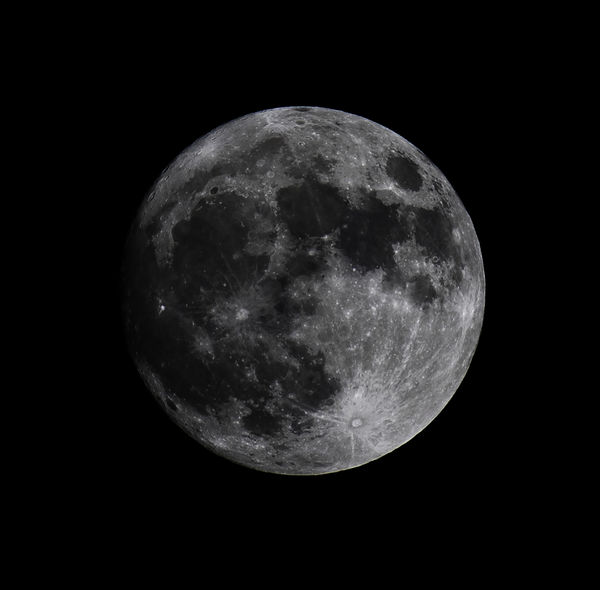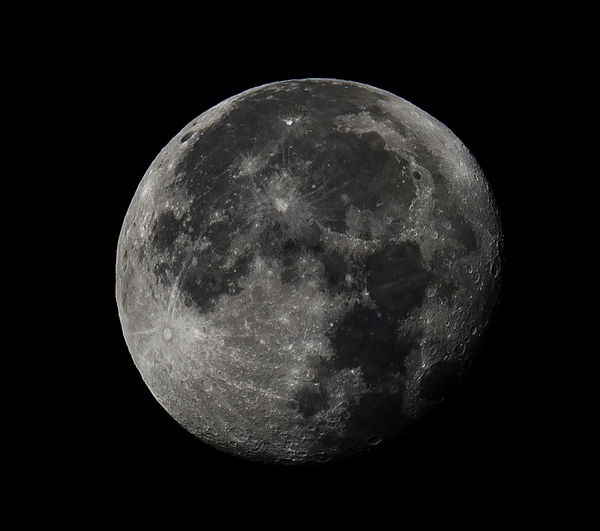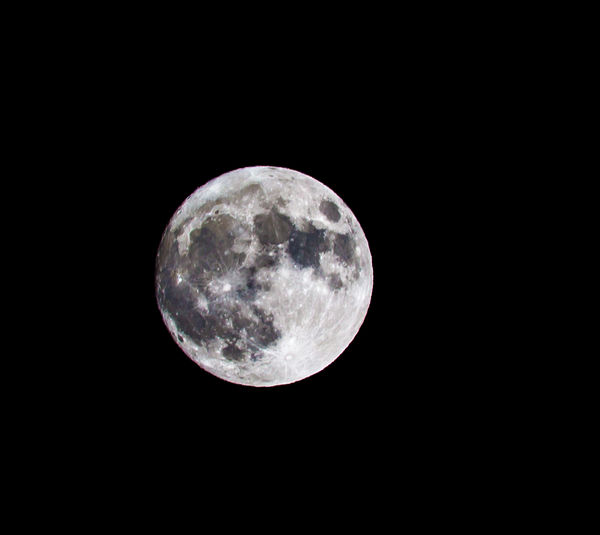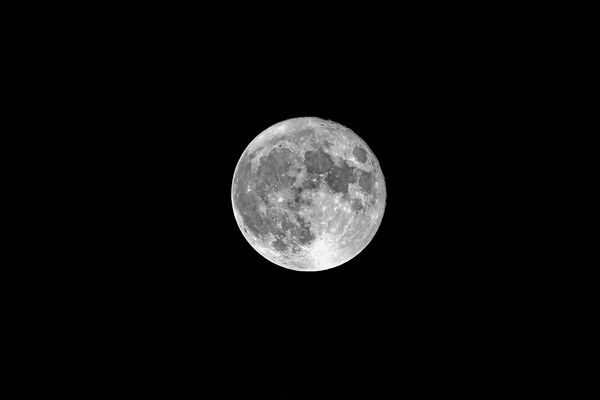Moon shots...
Nov 16, 2016 20:40:12 #
No, I am not going to inflict you with my version (i did not bother anyway) but I have a question...
Many of the 'offerings' show an interesting problem (and I am not referring to lack of focus)...
Many show a good definition toward the edges of the moon but the center is almost always fuzzy. I am puzzled with that. The first one I spotted I chalked it at overzealous sharpening but then I saw it several times from other users.
Can anyone tell me what is going on here?
Many of the 'offerings' show an interesting problem (and I am not referring to lack of focus)...
Many show a good definition toward the edges of the moon but the center is almost always fuzzy. I am puzzled with that. The first one I spotted I chalked it at overzealous sharpening but then I saw it several times from other users.
Can anyone tell me what is going on here?
Nov 16, 2016 20:51:53 #
Rongnongno wrote:
No, I am not going to inflict you with my version (i did not bother anyway) but I have a question...
Many of the 'offerings' show an interesting problem (and I am not referring to lack of focus)...
Many show a good definition toward the edges of the moon but the center is almost always fuzzy. I am puzzled with that. The first one I spotted I chalked it at overzealous sharpening but then I saw it several times from other users.
Can anyone tell me what is going on here?
Many of the 'offerings' show an interesting problem (and I am not referring to lack of focus)...
Many show a good definition toward the edges of the moon but the center is almost always fuzzy. I am puzzled with that. The first one I spotted I chalked it at overzealous sharpening but then I saw it several times from other users.
Can anyone tell me what is going on here?
DoF???? Because it's a sphere, the center is closer than the edges???????
Nov 16, 2016 21:14:09 #
What I think is that the moon is quite bright washing out the surface except near the edges where it doesn't, showing the craters in relief. Also, it can be difficult getting an extremely sharp shot because of effects from Earth's atmosphere. I tried to get some moon shots last week, and they were all rather blurry, looking more like a white blob. As I was packing up, I noticed there had developed a heavy ring around the moon indicating there's a lot of moisture up there which interferes with sharpness. There are other atmospheric conditions that can interfere too, I've read, but can't remember the details.
I have taken fairly good images of the moon with this camera before, a P610 with 1440mm telephoto, so I know it wasn't the camera. It could have been my fault, but I doubt it, because I took a lot of shots trying different settings, and all I got was a blob each time. It was hopeless.
I have taken fairly good images of the moon with this camera before, a P610 with 1440mm telephoto, so I know it wasn't the camera. It could have been my fault, but I doubt it, because I took a lot of shots trying different settings, and all I got was a blob each time. It was hopeless.
Nov 16, 2016 21:23:11 #
Rongnongno wrote:
No, I am not going to inflict you with my version (i did not bother anyway) but I have a question...
Many of the 'offerings' show an interesting problem (and I am not referring to lack of focus)...
Many show a good definition toward the edges of the moon but the center is almost always fuzzy. I am puzzled with that. The first one I spotted I chalked it at overzealous sharpening but then I saw it several times from other users.
Can anyone tell me what is going on here?
Many of the 'offerings' show an interesting problem (and I am not referring to lack of focus)...
Many show a good definition toward the edges of the moon but the center is almost always fuzzy. I am puzzled with that. The first one I spotted I chalked it at overzealous sharpening but then I saw it several times from other users.
Can anyone tell me what is going on here?
Could it be that you have a bit of cataract in the centers of your eyes, making the centers appear fuzzy?!?!
Try looking at the pics with your gaze a bit askew so your seeing from the corners of your eyes....., see if that is better!!!!

SS
Nov 16, 2016 21:25:13 #
Mac wrote:
DoF???? Because it's a sphere, the center is closer than the edges???????
So what's the DoF at 240,000 miles at that f-stop??
Is it less than 1/2 the diameter of the moon?!
SS
Nov 16, 2016 21:30:34 #
SharpShooter wrote:
So what's the DoF at 240,000 miles at that f-stop??
Is it less than 1/2 the diameter of the moon?!
SS
Is it less than 1/2 the diameter of the moon?!
SS
At what f/stop?
Nov 16, 2016 22:13:47 #
RWR
Loc: La Mesa, CA
Rongnongno wrote:
No, I am not going to inflict you with my version (i did not bother anyway) but I have a question...
Many of the 'offerings' show an interesting problem (and I am not referring to lack of focus)...
Many show a good definition toward the edges of the moon but the center is almost always fuzzy. I am puzzled with that. The first one I spotted I chalked it at overzealous sharpening but then I saw it several times from other users.
Can anyone tell me what is going on here?
Many of the 'offerings' show an interesting problem (and I am not referring to lack of focus)...
Many show a good definition toward the edges of the moon but the center is almost always fuzzy. I am puzzled with that. The first one I spotted I chalked it at overzealous sharpening but then I saw it several times from other users.
Can anyone tell me what is going on here?
The culprit is moondust. It’s a little know fact that our view of the moon from earth is looking straight down at it. You can duplicate the effect by sprinkling talcum powder on a balloon. Notice how it falls off the sides, leaving the surface clear?
Nov 16, 2016 23:00:49 #
Rongnongno wrote:
No, I am not going to inflict you with my version (i did not bother anyway) but I have a question...
Many of the 'offerings' show an interesting problem (and I am not referring to lack of focus)...
Many show a good definition toward the edges of the moon but the center is almost always fuzzy. I am puzzled with that. The first one I spotted I chalked it at overzealous sharpening but then I saw it several times from other users.
Can anyone tell me what is going on here?
Many of the 'offerings' show an interesting problem (and I am not referring to lack of focus)...
Many show a good definition toward the edges of the moon but the center is almost always fuzzy. I am puzzled with that. The first one I spotted I chalked it at overzealous sharpening but then I saw it several times from other users.
Can anyone tell me what is going on here?
In moon shots, the brightest part of the moon is subjected to direct sunlight - resulting in no shadows. around the outer edges, the sunlight is at a greater angle so shadows develop giving a better sense of perspective. The photos of partial moonlight are always showing more shadow of the craters and their walls creating a sharper image. My moon images are taken with a Canon 5D Mk IV and a 100-400 "L" MkII - 1/400, F5.6, ISO 100 the pp in light room maximizing contrast and sharpness, then to PShop adding more contrast and laght/dark adjustments. Of course I have the stabilizer on.
Nov 17, 2016 01:15:05 #
SharpShooter wrote:
So what's the DoF at 240,000 miles at that f-stop??
Is it less than 1/2 the diameter of the moon?!
SS
Is it less than 1/2 the diameter of the moon?!
SS
Assume a FF Canon with a 300 mm lens t f/5.6 Mathematically DoF is less than 10 km; at the resolution of modern cameras, it's infinite. I may try to calculate it for a 24 X 30 sensor with a 100" lens @ f/256, but I'll need the larger computer to insert the greater parameters.
UPDATE: An 8 X 10 with a 1000mm lens at f/256 is mathematically is <0.5 km.
Nov 17, 2016 06:46:38 #
dugole wrote:
In moon shots, the brightest part of the moon is s... (show quote)
Why would you want the stabilizer on? Hand hold?
5DIII, same lens. 1/125 f/11 ISO 100 tripod and IS OFF! Spot Focus. Some basic Lightroom changes.
Nov 17, 2016 07:25:55 #
dugole wrote:
In moon shots, the brightest part of the moon is s... (show quote)
Doug, I need to ask this question. Did you notice that the view between your two photos rotated the moon 90 degrees to the left? The same thing happened to me a couple of months ago and I know I did not rotate it. Any idea as to what changed?
Greg
Nov 17, 2016 10:03:39 #
I
I believe it because the sun is so bright on the moon that that part of the moon it eliminates all detail which in turn makes it look unsharp but as the light falls off along the edges of the moon they appear sharper. That is why most good photos of the moon always are ones that are not full. Here is a photo Itook of the full moon and if you double click on the download you will see the craters on the right edge but the center there is not much detail. This photo was taken with the Tamron 150-600 at 600mm,ISO 200, and 1000sec at f6.3 hand held ...Rich
Rongnongno wrote:
No, I am not going to inflict you with my version (i did not bother anyway) but I have a question...
Many of the 'offerings' show an interesting problem (and I am not referring to lack of focus)...
Many show a good definition toward the edges of the moon but the center is almost always fuzzy. I am puzzled with that. The first one I spotted I chalked it at overzealous sharpening but then I saw it several times from other users.
Can anyone tell me what is going on here?
Many of the 'offerings' show an interesting problem (and I am not referring to lack of focus)...
Many show a good definition toward the edges of the moon but the center is almost always fuzzy. I am puzzled with that. The first one I spotted I chalked it at overzealous sharpening but then I saw it several times from other users.
Can anyone tell me what is going on here?
I believe it because the sun is so bright on the moon that that part of the moon it eliminates all detail which in turn makes it look unsharp but as the light falls off along the edges of the moon they appear sharper. That is why most good photos of the moon always are ones that are not full. Here is a photo Itook of the full moon and if you double click on the download you will see the craters on the right edge but the center there is not much detail. This photo was taken with the Tamron 150-600 at 600mm,ISO 200, and 1000sec at f6.3 hand held ...Rich
Nov 17, 2016 10:54:58 #
CLF wrote:
Doug, I need to ask this question. Did you notice that the view between your two photos rotated the moon 90 degrees to the left? The same thing happened to me a couple of months ago and I know I did not rotate it. Any idea as to what changed?
Greg
Greg
They are not my shots but now that I take a close look I see it. All I know is that most PPing tools will allow one to rotate an photo. Would FB take liberties?
At a loss!
Nov 17, 2016 10:57:08 #
CLF wrote:
Doug, I need to ask this question. Did you notice that the view between your two photos rotated the moon 90 degrees to the left? The same thing happened to me a couple of months ago and I know I did not rotate it. Any idea as to what changed?
Greg
Greg
Allow me to butt in on the answer... although the same side of the moon is always facing the earth, the moon does rotate like the hands of a clock. That's one reason we use a "wedge" with telescopes when we want to take planetary pictures instead of a stationary tripod... even on a tracking telescope mount we still need a wedge to follow not only the left to right movement of the moon, but the rotation as well... if the exposure is less than about 1/2 second, the rotation shouldn't be noticed... but when looked at after a couple of hours, the part of the moon that we see will have rotated... I'll butt out now... :-)
Nov 17, 2016 11:04:07 #
billgdyoung wrote:
Allow me to butt in on the answer... although the ... (show quote)
This individual that took the photos will have to tell us the time difference. I assumed they we close together..
If you want to reply, then register here. Registration is free and your account is created instantly, so you can post right away.













